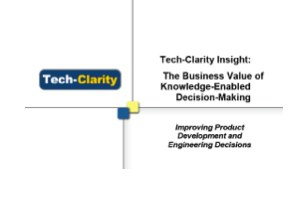 Tech-Clarity Insight: The Business Value of Knowledge-Enabled Decision-Making – Improving Product Development and Engineering Decisions shares the perspectives of three manufactures (Kimberly-Clark, Robert Bosch, and Rolls-Royce) on the value of applying knowledge-based decision-making techniques including semantic search and engineering tools. The paper also provides a template to calculate the ROI of a knowledge-based decision-making implementation and offers a representative example showing very tangible business benefits from improved search efficiency alone.
Tech-Clarity Insight: The Business Value of Knowledge-Enabled Decision-Making – Improving Product Development and Engineering Decisions shares the perspectives of three manufactures (Kimberly-Clark, Robert Bosch, and Rolls-Royce) on the value of applying knowledge-based decision-making techniques including semantic search and engineering tools. The paper also provides a template to calculate the ROI of a knowledge-based decision-making implementation and offers a representative example showing very tangible business benefits from improved search efficiency alone.
Please enjoy the summary below. Click the report or title to download a PDF overview of the report (free of charge, no registration required).
For the full report, visit the Invention Machine (IHS) website (registration required).
See the related IHS webcast Measuring the Value of Knowledge-Based Product Decisions (registration required).
Table of Contents
- Executive Overview
- The Demand for Timely, Relevant Knowledge
- Too Much Information and not Enough Knowledge
- Recognize why Knowledge Management Remains a Challenge
- Improve Access to Knowledge with Semantic Search
- Understand the Basics of Semantic Search
- Extend Semantic Search with Advanced Search Tools
- Extend Semantic Search with Engineering Tools
- Understand the Value of Knowledge-Based Decision-Making
- Quantify the Value of Knowledge-Based Decision-Making
- Calculate the Benefits
- Conclusion
- Recommendations
- About the Author
Executive Overview
Optimizing the multitude of important decisions in innovation, R&D, and product development requires more than hiring the right people. Effective product decision-making demands companies make the most relevant information available to decision-makers in the right context. Innovation and problem solving require a broad array of knowledge. This information is scattered across internal and external sources such as research libraries, patent databases, and more. Further, it consists of information in many formats, document types, and languages. Aggregating and accessing the right information from the exploding volume of digital information is a significant challenge, making knowledge access an important enabler of innovation. As Tech-Clarity’s Product Data Accessibility report concludes, accessing accurate, timely information “is vital to the health and profitability of a manufacturing company.”
Modern search technology offers much better value than traditional, costly knowledge management approaches that require data to be centralized, harmonized, and categorized in advance of knowing what information will actually be needed! Purpose-built semantic research tools are emerging that provide much more focused results and cut search time dramatically. “When you are searching a small amount of information, keyword searches will probably do well,” explains Sridhar Ranganathan, Technical Leader at Kimberly-Clark Corporation, “But now with so much available information, just a keyword will return too much noise.” Semantic search offers more effective knowledge retrieval without having to organize information in advance, particularly when searching large volumes of information. “Semantic search adds another dimension to the search to slice through the huge gobs of data you have more quickly,” Mr. Ranganathan explains.
Developing a targeted search to drive innovation decisions is dramatically improved by translating complex problems into the fundamental, conceptual challenges that need to be addressed. Proven engineering techniques offer the opportunity to methodically break problems down into systems elements or root causes so researchers can retrieve relevant information from the vast amount of digital knowledge available today. Defining the right question to ask helps researchers find solutions from others who have solved similar problems in the past, perhaps in a different industry. Knowledge-enabled decision-making combines semantic search with engineering methods to help companies frame questions appropriately, allowing them to retrieve the most relevant information – across languages, industries and fields of study – to make better decisions.
But how do you put a value on knowledge-enabled decision-making? The benefits can be invaluable, such as providing researchers with the insight to open up new markets, improve new products, or encourage greater innovation. It can also provide strategic benefits such as protecting intellectual property or discovering room to operate among existing patents. These benefits are both incredibly strategic and highly variable, but also difficult to quantify. Fortunately a highly concrete ROI is available even if companies disregard the strategic benefits and only consider tactical time savings, particularly when teams are already overworked and headcounts aren’t growing. “Even though quantifying the value is very hard, a survey among power users shows that researchers are shortening the time it takes to find solutions by using semantic search,” offers Peter Guse of Corporate Research, Innovation Management at Robert Bosch GmbH.
This report provides a template to calculate these benefits based on tangible, bottom-line savings. This template is based on US census data and interviews for this paper. Applying the metrics derived from this research to a representative manufacturing company shows a cost savings of over $650,000 annually. While it’s important to remember that these are the tactical benefits and they are potentially dwarfed by the benefits of finding a new innovative product, entering a new market, or finding room to operate within a tangled web of patents, it is likely more than enough to pay for the cost of implementing knowledge-enabled decision-making technology.

